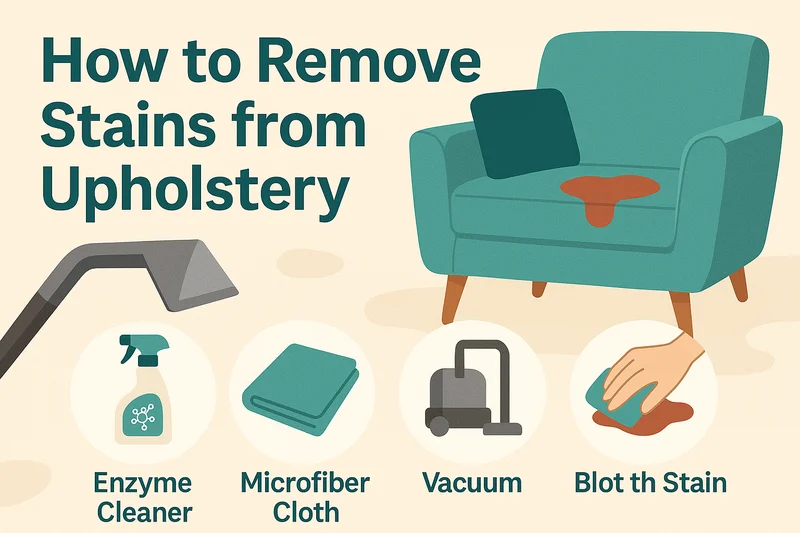🛋️ How to Remove Stains from Upholstery: Effective Methods for Every Type of Stain

Stains on your couch or chair are inevitable, but knowing how to remove stains from upholstery quickly and effectively can save your furniture. This upholstery stain removal guide covers everything from red wine spills to pet accidents, helping you choose the best way to clean stains from your couch using safe and proven methods.
🧾 Quick Stain Removal Table
| Stain Type | Recommended Method | Important Tips |
|---|---|---|
| 🟥 Red Wine | Blot + enzyme prespray + warm rinse | Act quickly before it sets |
| ☕ Coffee/Tea | Mild detergent + warm water | Avoid overwetting, blot instead of rubbing |
| 🧴 Grease/Oil | Solvent-based spot cleaner | Blot excess first, avoid water |
| ✍️ Ink | Solvent-based cleaner (spot test) | Do not scrub, apply gently |
| 💧 Urine (Pet/Human) | Enzyme cleaner + deep extraction | Use odor neutralizer after |
| ❤️ Blood | Cold water + enzyme prespray | Never use hot water |
| 🤢 Vomit | Enzyme cleaner + rinse | Wear gloves, remove solids first |
| 🍄 Mold/Mildew | Specialized anti-mold cleaner | Clean in ventilated area, dry thoroughly |
🧼 General Rules for Removing Upholstery Stains
✅ Act fast – the longer a stain sits, the harder it is to remove.
✅ Blot, don’t rub – always blot from the outside in to avoid spreading.
✅ Test before treating – apply any cleaner on a hidden area first.
✅ Use cold water for protein-based stains like blood and urine.
❌ Avoid bleach unless the fabric care tag explicitly allows it.
❌ Don’t oversaturate the fabric – it can lead to mold growth or cushion damage.
🧵 Cleaning Methods by Fabric Type
| Fabric Type | Recommended Cleaning Approach | Notes |
|---|---|---|
| Microfiber | Mild detergent, foam, or light extraction | Blot gently, dries quickly |
| Velvet | Dry or foam cleaning only | Avoid water-based methods |
| Linen | Dry cleaning preferred | Water can shrink the fabric |
| Synthetic Blends | Extraction or enzyme spray | Sturdy, versatile with most methods |
| Cotton | Extraction or mild soap solution | Allow full drying after cleaning |
🧪 Best Methods to Remove Upholstery Stains
1. Enzyme Pre-treatment + Extraction
Use for: Pet stains, urine, blood, food spills
- Spray enzyme-based cleaner and let it dwell.
- Perform deep extraction using warm water.
2. Solvent Spot Cleaning
Use for: Ink, oil, grease
- Apply solvent cleaner on a cloth.
- Gently dab, avoid over-wetting the fabric.
3. Mild Detergent Solution
Use for: Coffee, tea, juices
- Mix a drop of dish soap in warm water.
- Blot gently with microfiber cloth.
4. Odor Neutralization
Use for: Urine, vomit, pet accidents
- Always finish cleaning with an odor treatment.
- Avoid perfumes—use odor removers designed for upholstery.
📦 Emergency Stain Response Kit
Keep these supplies at home for stain emergencies:
- Microfiber cloths (white)
- Spray bottle with clean water
- Disposable gloves
- Enzyme-based cleaner
- Solvent spot remover
- Odor neutralizer
❓ Expanded FAQ
Q: How to get stains out of a sofa with natural products?
A: Try mild baking soda for odors and vinegar + water for surface stains. Always patch test first.
Q: Is baking soda safe for fabric couches?
A: Yes, but vacuum thoroughly afterward. Use it primarily for odor absorption.
Q: Can I use vinegar to clean my couch?
A: Only on vinegar-safe materials. Avoid it on velvet or silk. Always check the tag.
Q: How to clean ink off upholstery?
A: Use a solvent-based cleaner, dab gently. Avoid smearing the stain.
Q: What’s the best way to clean stains from a couch with pets?
A: Use enzyme cleaners and deep clean regularly. Odor neutralization is key.
Q: When should I call a professional upholstery cleaner?
A: For large stains, deep odors, delicate fabrics, or if DIY methods fail.
Q: Can stains come back after cleaning?
A: Yes, if not properly extracted. Use airflow to ensure thorough drying.
Q: Is it better to deep clean stained couch professionally?
A: For persistent or old stains, yes. Professional extraction reaches deep layers.
Final Checklist: How to Handle Upholstery Stains
✅ Identify the fabric type (check the care tag on the furniture)
✅ Determine the nature of the stain: organic (food, urine), protein (blood), or chemical (ink, oil)
✅ Select the appropriate cleaning method for the fabric and stain type
✅ Blot the stain gently without rubbing or spreading it further
✅ Test all products on a hidden area before full application
✅ Rinse with clean water if necessary, and extract excess moisture
✅ Allow the area to dry fully using airflow or fans
✅ Apply odor neutralizer if the stain involved pet urine, vomit, or similar
✅ If the stain persists or the fabric is delicate — contact a professional upholstery cleaner
📣 Final Thoughts
Knowing how to remove stains from upholstery is essential for every household. By understanding the fabric and stain type, you can use safe, targeted methods to protect your furniture.
For best results, act quickly, use appropriate cleaners, and when in doubt—consult a professional.
Need help with deep clean stained couch or odor removal? Contact us for professional upholstery cleaning with guaranteed results!
